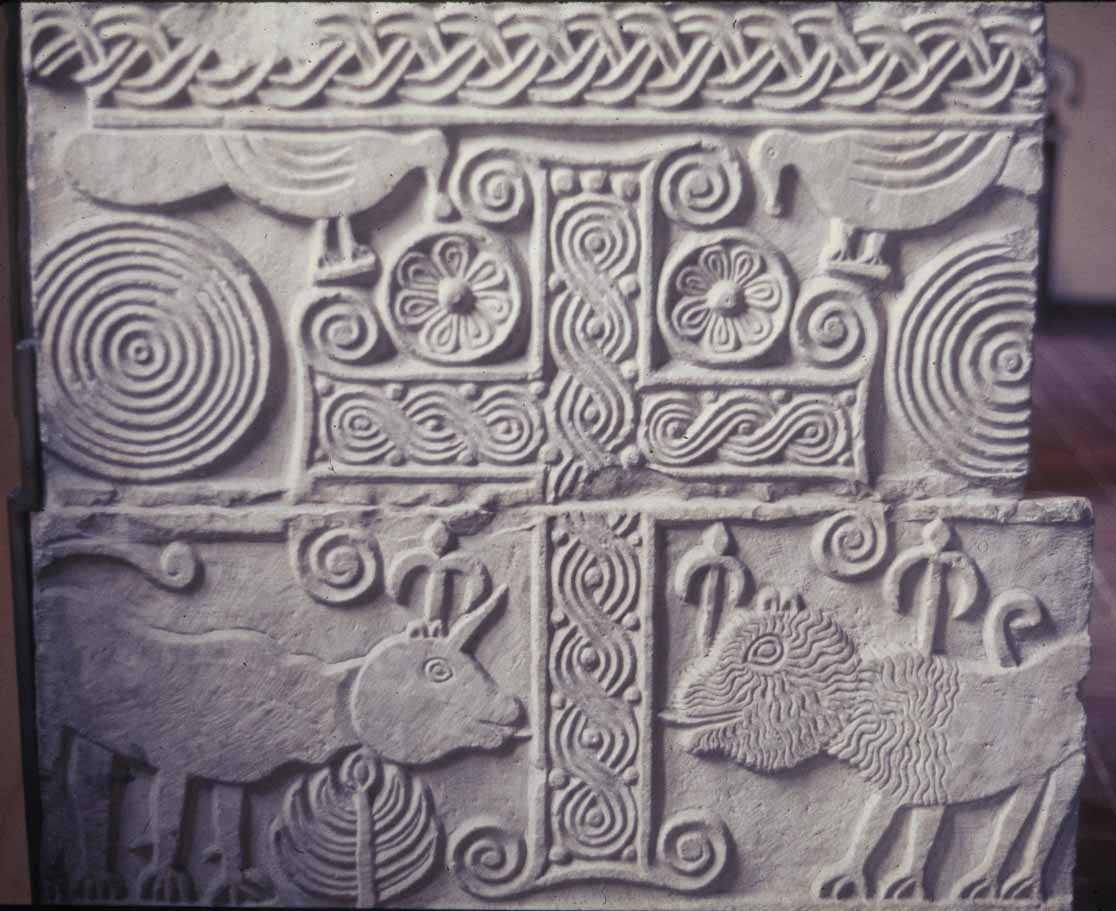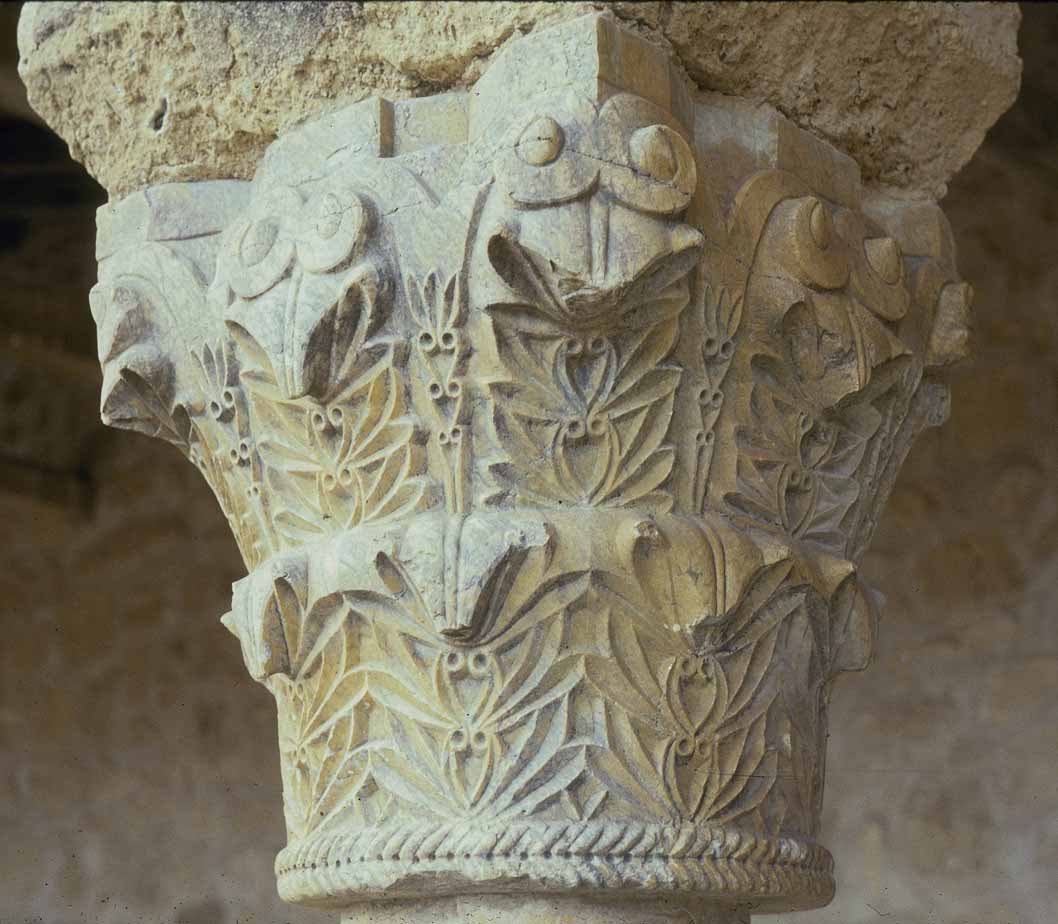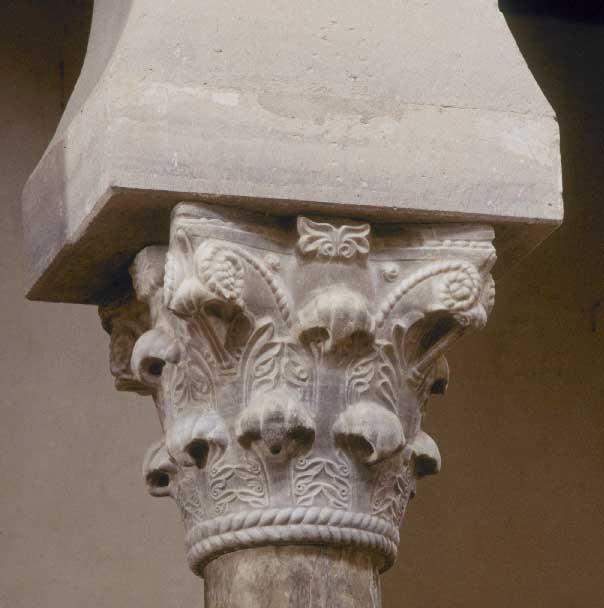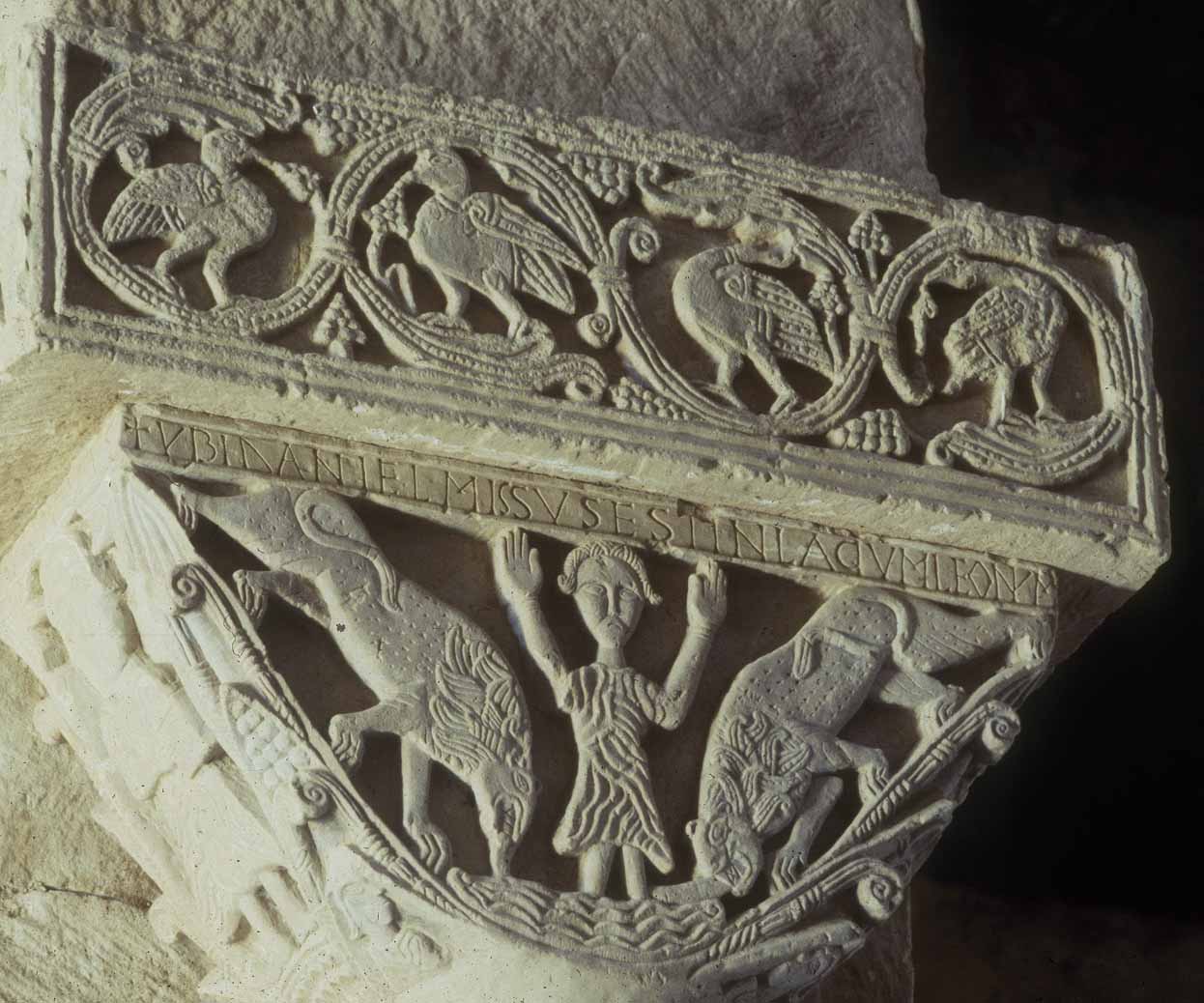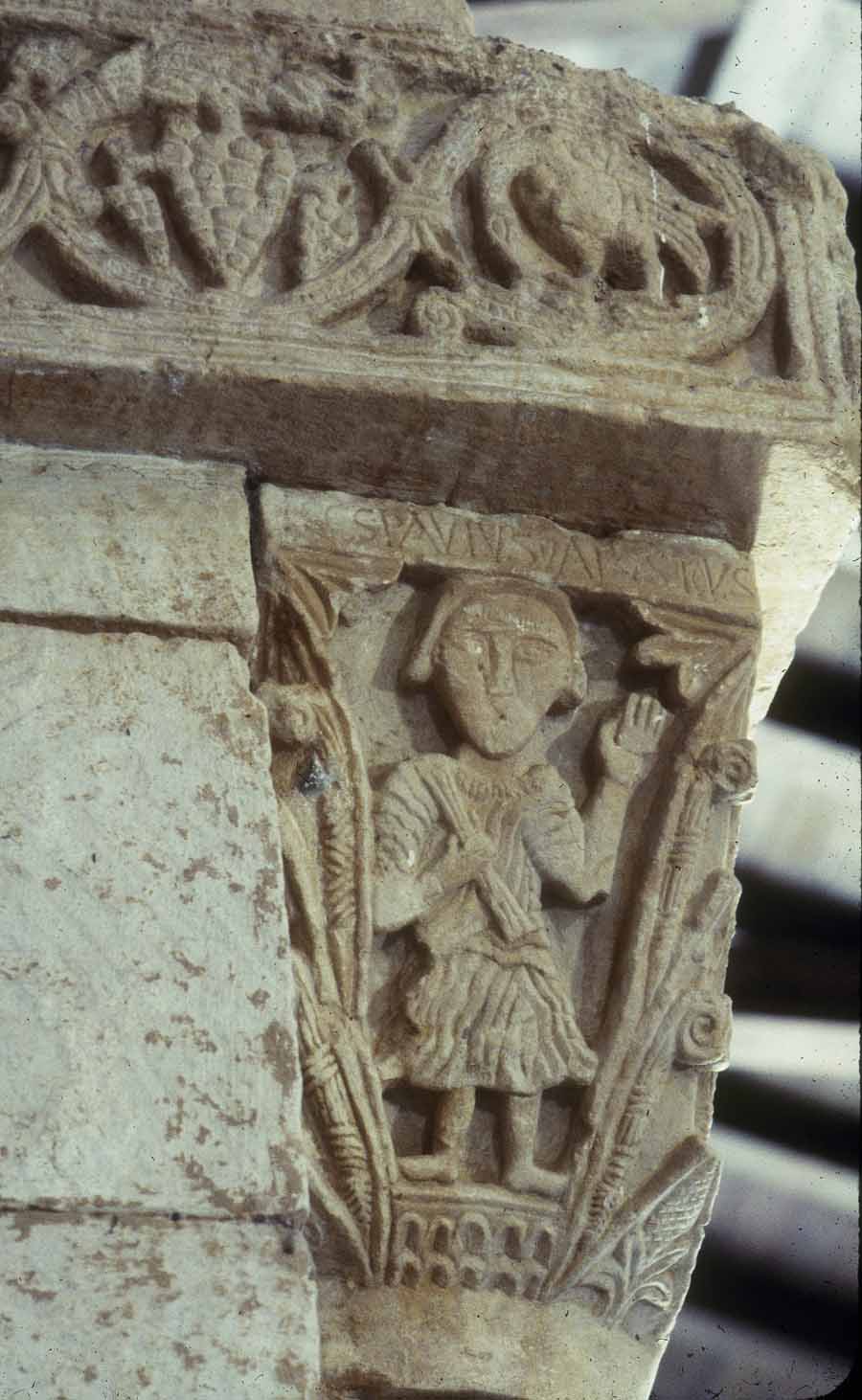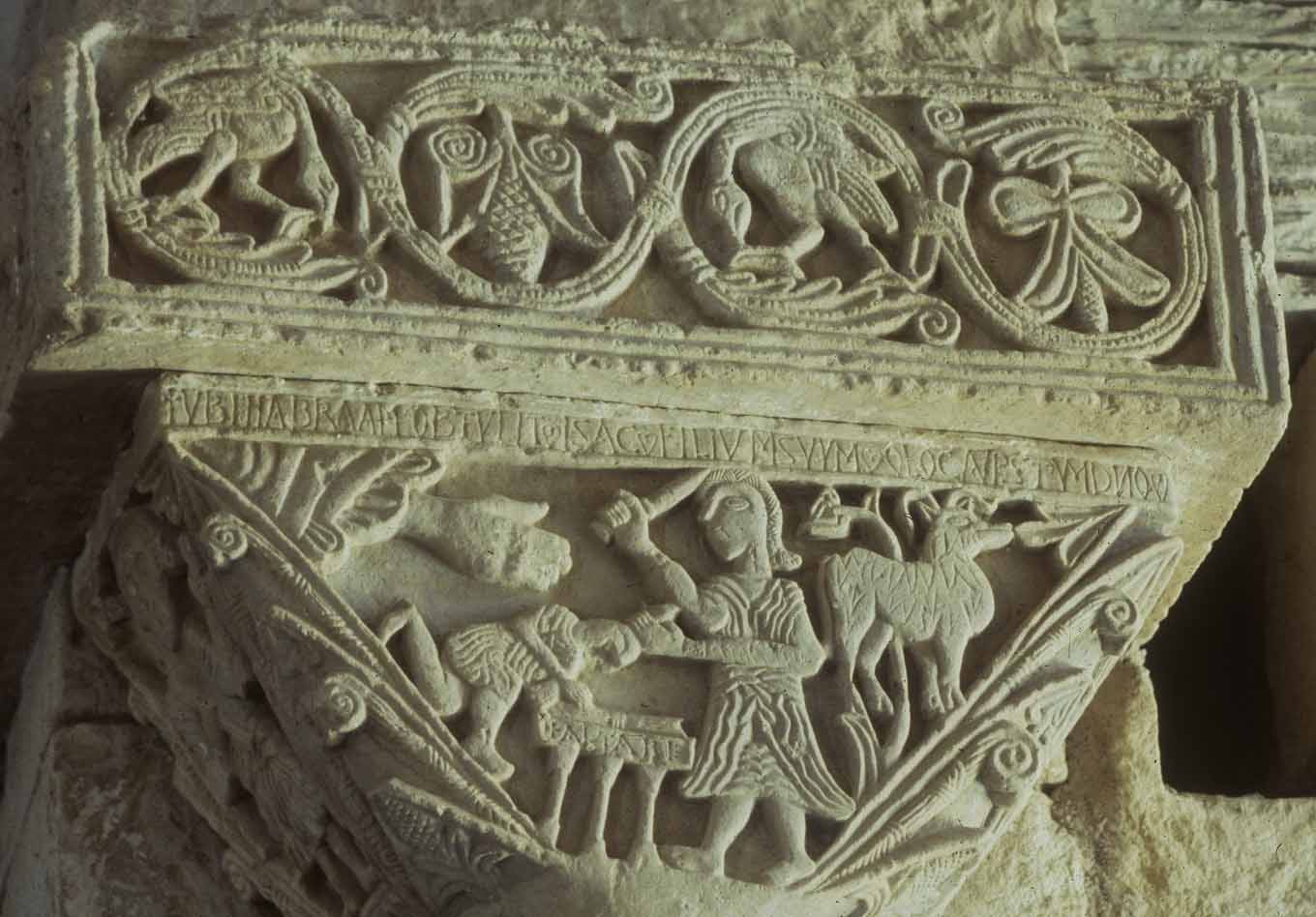NOVEMBER 27/28/29: THE EARLY
MIDDLE
AGES: LOST WORLDS
READINGS (Monday, November 27): The Anglo-Saxon World, pp. 144-48,
182-85 (The Dream of the Rood), 251-59 (Allegories), 272-75 (The
Fortunes of Men)
READINGS (Tuesday night, November 28): The Anglo-Saxon World, pp. 44-56
(Elegies), 61-142 (Beowulf), 144-48, 182-85 (The Dream of the Rood),
251-59 (Allegories), 272-75 (The Fortunes of Men)
READINGS (Wednesday, November 29): The Anglo-Saxon World, pp. 44-56
(Elegies), 61-142 (Beowulf)
Summary: In this class, we turn from the individual conversion to
Christianity, described in Augustine's Confessions, to the
transformation of a society and culture, that of early medieval
Britain. We will use the British Isles as an example of how an early
medieval culture arose from
the blending of different cultural traditions: the legacy of Rome, the
Judeo-Christian writings of the Bible, the institutions of
Christianity, and the heritage of the Germanic and Celtic peoples of
northern Europe.
Seventh-, eighth- and ninth-century works of art
from the British Isles - the treasure from the Sutton Hoo ship burial
and the splendid gospel manuscripts from the monasteries of Britain and
Ireland - illustrate the diverse cultural traditions and wide-ranging
contacts
of the Anglo-Saxons at the time of their conversion to Christianity in
the seventh century. The illuminated manuscripts, in particular,
provide
evidence of the complex process of accommodation among the different
Christian
traditions of Celtic Ireland, Anglo-Saxon England, Rome, and the
Mediterranean
in the seventh and eighth centuries.
Beowulf, a poem composed in Old English, probably
in the eighth or ninth century, gives a glimpse of the earlier legends,
heroic tales, and history of the pagan peoples of northern Europe,
Britain, and Scandinavia. The author, however, speaks from a Christian
perspective for a Christian audience. He links the traditional tales
with biblical history, and occasionally offers moralizing commentaries.
The strange tale and lament of the last survivor who had "cautiously
concealed ancient treasures, the enormous legacy of a noble people" (p.
130) and the gloomy tone of nostalgia and foreboding throughout the
poem
remind us that this is a fleeting image
of a lost world.
HISTORICAL SETTING: ROME, CHRISTIANITY AND THE BRITISH ISLES
Roman troops withdrew from Britain in 410, after
occupying
much of the island since the first century. Christianity had spread
among
the native Britons before the Roman forces withdrew. During the fifth
and
sixth centuries, pagan Germanic peoples of diverse tribes - Angles,
Saxons,
Jutes, Frisians, and Danes (
some of the peoples remembered in Beowulf
) - settled in eastern and southern England. In 597,
Pope Gregory I
the
Great (590-604) sent a Christian mission led by
Augustine (
not the author of the Confessions!!!) to the southeastern kingdom
of
Kent. King
Ethelbert of Kent was a pagan, but he was
married
to a Christian princess,
Bertha, from the
Merovingian
kingdom
of the Franks (in what is now France). Ethelbert converted to
Christianity,
and Christianity gradually spread among neighboring kingdoms, like
Essex
and East Anglia (
site of the Sutton Hoo ship burial), as well.
The
king of
Northumbria,
Edwin, married a Christian
princess,
Ethelburga, from Kent, and she was accompanied by an Italian
priest,
Paulinus, who had been part of Augustine's mission. Edwin
was baptized in 627, but he was killed in battle in 632. The pagan
invaders
were driven out and a rival branch of the Northumbrian royal family
took
the throne. The new king,
Oswald (634-42) and his brother,
Oswy
(642-70), had spent time in exile in Scotland where they had been
converted
to Christianity by the Irish monks of
Iona. As kings, they
brought
the monk
Aidan from Iona to Northumbria where he established a
monastery
at
Lindisfarne (
where the Lindisfarne Gospels were later made
). In 664, differences between the Irish church and the Roman
missionaries
were settled in favor of Roman practices at the
Synod of Whitby
in
Northumbria, and, over the next century, Irish monasteries gradually
accepted
the decisions. Northumbrian monasteries, like
Benedict Biscop's
foundation
at
Wearmouth-Jarrow, maintained close ties with Rome: clergymen
visited
Rome, and books and objects of art were exchanged.
Christianity had come to Ireland from Britain in
the
fifth century. Ireland had never formed part of the Roman empire, and
the
conversion of the Irish to Christianity is traditionally credited to
Patrick
, a fifth-century Briton who had been taken into slavery in Ireland as
a
youth, escaped, and later returned to Ireland to convert the pagan
Irish.
A bishop
Palladius had preceded him (c. 431), but little is
known
about his work. In the sixth and seventh centuries, the Irish church
developed
a distinctly monastic character.
Monasticism was a form of the
religious
life that, in varying degrees, involved the withdrawal from the world,
the
renunciation of personal property, and the adoption of a life of
prayer,
fasting, and sexual abstinence. Monks typically lived within
communities,
and pledged obedience to an
abbot; some embarked upon the more
demanding
solitary life of the
hermit. Within Christianity, the monastic
movement
developed in fourth-century Egypt, and is associated with
Antony,
who led the eremitic life of a solitary, and
Pachomius, who
founded
large monastic communities in the Egyptian desert.
Columba
(died 597)
was a important figure in the monastic church of early Ireland, and he
founded
a family of linked monasteries, including those at
Durrow (
where
the Book of Durrow may have been made) and Iona.
Columbanus
(died
615) travelled to the European continent, and, with followers, founded
monasteries
in France and Italy.
IMPORTANT SITES AND WORKS OF ART FROM EARLY MEDIEVAL BRITAIN AND IRELAND
-THE SUTTON HOO SHIP BURIAL
The ship burial at Sutton Hoo is believed to be the grave of the East
Anglian
King
Raedwald who died c. 625. It was first excavated in 1939,
and
the treasure included arms and armor, gold coins, gold and jeweled
objects
of personal adornment, bowls, drinking cups, and textiles. They display
extraordinary
craftsmanship, and the objects show the wide-ranging connections of the
Anglo-Saxon
kings. They include, for example, silver bowls and tableware from the
eastern
Mediterranean, a hanging bowl decorated with enamels and glass in a
Celtic
style, gold coins from the Merovingian kingdom in Gaul (modern France),
and
several pieces of Anglo-Saxon manufacture adorned with garnets and
glass.
Web sites: 1) the treasure in the collection of the
British Museum , 2)
the
Sutton Hoo site
-
ILLUMINATED MANUSCRIPTS
-THE BOOK OF DURROW
The Book of Durrow is a
gospel book generally dated to the late
seventh
century and believed to be from Durrow, an Irish monastery founded in
the
middle of the sixth century by Columba. It includes
decorated
lettering
,
interlace and a wide variety of geometric motifs, curvilinear
designs
and highly stylized animals, particularly on the so-called
carpet
pages
. These pages, covered with ornamental decoration, face the opening
page
of each gospel, and they resemble the decoration of contemporary
metalwork,
like some of the pieces from Sutton Hoo. There are also full-page
representations
of the symbols of the
evangelists, in a highly colored,
abstract style.
Web sites: 1)
illustrations of pages from the manuscript
; 2)
brief discussion of the manuscript
-THE LINDISFARNE GOSPELS
The Lindisfarne Gospels were probably produced at Lindisfarne, the
Northumbrian
monastery founded by Aidan. The book includes a
colophon (
an
endnote
explaining the circumstances of the book's making) added by an
Anglo-Saxon
monk,
Aldred, c. 950-60, who also added an interlinear Old
English
translation of the Gospels to the Latin text. Aldred attributed the
making
of the book to bishop
Eadfrith of Lindisfarne (698-721), its
binding
to his successor, bishop
Aethilwold (c. 721-40), and its metal
decoration
(now lost) to the hermit or anchorite,
Billfrith. Scholars have
generally
accepted this information, and the book is likely to have been made in
the
early eighth century, perhaps as part of the promotion of the cult of
St. Cuthbert, a monk and bishop of Lindisfarne (died 687) whose
tomb
was venerated there.
It is a large (343x248 mm), luxury manuscript that always would have
been
intended for display, not for use: the large
parchment pages
were
made from carefully prepared calfskin (
vellum), and the skins of
more
than one hundred and fifty calves may have been needed. Besides the
four
gospels, the book includes the introductory preface of
Jerome
(who
translated the Bible into the Latin version known as the
Vulgate),
and the individual gospels have prefatory material on their authorship
and
their use in the liturgy. The book is splendidly decorated with
canon
tables (
concordances indexing the passages shared by different
gospels
) set in architectural frames, portraits of the evangelists in human
form,
intricate carpet pages, and magnificently enlarged and decorated
lettering
on the opening page of each gospel. There are also numerous smaller
initial
letters with different degrees of colored decoration.
Web sites: 1)
British Museum exhibition
; 2)
Virtual Seminar: Michelle Brown's discussion of the manuscript
; 3)
additional illustrations
-
THE BOOK OF KELLS
The Book of Kells is one of the most famous of all medieval manuscripts
because
of its rich and intricate decoration. It is generally dated to the late
eighth
century, and many scholars believe it was produced at Iona. Besides the
elaborate
canon tables, decorated initials and a proliferation of ornament on
minor
letters, it includes several distinctive full-page illustrations, e.g.,
the
Temptation of Christ, the Arrest of Christ, and the Virgin and Child.
Web sites: 1)
illustrations of pages from the manuscript
GLIMPSES OF THE SCULPTURE OF EARLY MEDIEVAL EUROPE
INTRODUCTION TO BEOWULF
The Old English poem, Beowulf, survives in a single
manuscript,
generally dated to the beginning of the eleventh century (c.
1000-1010),
and that manuscript was damaged in a fire in 1731. All of our editions
of
the text are based on this one example. Scholars disagree widely about
when
and where the poem was composed, and what roles oral traditions,
formulaic
composition, and scribal editing may have had in the formation of the
text.
Proposed dates for the poem range from the early eighth to the early
eleventh
century.
The poem is set in the pagan Germanic past, among
the
peoples inhabiting the coasts of the North Sea. Other sources make it
possible
to relate one of the kings mentioned in Beowulf, king Hygelac of the
Geats,
to a historical event in the early sixth century. While the setting of
the
poem and the characters within it are pagan, the author refers directly
-
and indirectly - to the Bible and Christianity. The poem has two
principal
parts of unequal length: in the first part, the Geatish warrior,
Beowulf,
travels to the Danish kingdom to aid king Hrothgar whose banqueting
hall,
Heorot, has been ravaged by a monster, Grendel. Beowulf slays Grendel
and,
in a second battle, kills Grendel's mother. Richly rewarded by
Hrothgar,
he returns to his kingdom and tells the story of his exploits to his
uncle,
king Hygelac of the Geats. Then, in the second - shorter - part, the
poet
jumps ahead to Beowulf's old age: king Hygelac was killed in battle;
his
son, Heardred, was killed by the Swedes; Beowulf succeeded to the
throne
and has now ruled for fifty years... In the final sections, he battles
with
a dragon that has been awoken and enraged by the theft of the treasure
he
guarded within a mound.
PRINCIPAL CHARACTERS AND NAMES
The Danes
-
Heremod: ancient Danish king, used as an example of a wicked
ruler (e.g., pp. 96, 116-17)
-
Scyld Scefing: mythological founder of the Danish royal
dynasty, great-grandfather of Hrothgar; the prologue describes his
mysterious arrival as a castaway, and his funeral on a ship laden with
treasure and set adrift
-
Hrothgar: Danish king, son of king Healfdene, husband of
Queen Wealhtheow, builder of the banqueting hall named
Heorot
-
Freawaru: daughter of Hrothgar, her marriage to
Ingeld
(pp. 124-25), prince of the Heathobards, will fail to settle the
feuds
between their houses
-
Hrothulf: the nephew of Hrothgar who later seized the throne
from Hrothgar's son,
Hrethric; his treachery is foreshadowed
(p. 103)
-
Unferth: a Danish warrior who killed his own brothers; he
challenged Beowulf upon his arrival, but later lent him his sword,
Hrunting
, which proved useless in the battle with Grendel's mother
-
Aeschere: a counsellor of Hrothgar, killed by Grendel's mother
The Geats (the people of the hero, Beowulf)
-
Hrethel: the former king of the Geats, father of Hygelac;
Beowulf
tells his story before he confronts the dragon (pp. 135-36)
-
Hygelac: king of the Geats, uncle of Beowulf; he is killed in a
battle with the Franks, during a feud he started with the Frisians.
-
Hygd: queen of the Geats
-
Heardred: son and successor of king Hygelac, killed by the
Swedes
-
Wiglaf: companion of Beowulf in his last fight with the dragon
The Monsters
-
Grendel: the monster or demon that ravages Heorot and is killed
by Beowulf; he is described as a descendant of the biblical figure
Cain , the wicked son of Adam and Eve who killed his brother, Abel,
and was the first murderer.
Outline of the Story
Prologue, pp. 74-75: a description of the mysterious arrival and
funeral of
Scyld Scefing, ancestor of the Danish kings
pp. 75-78: The Danish king,
Hrothgar, builds the great
banqueting hall,
Heorot, but it is ravaged and left desolate by
Grendel , the monstrous descendant of
Cain.
pp. 79-86: Beowulf, a warrior of the
Geats, learns of
Hrothgar's troubles, and travels to the Danish kingdom to subdue
Grendel. Wulfgar presents Beowulf and his men to King Hrothgar, and
Beowulf declares that he will
fight Grendel. Hrothgar remembers how he once protected Beowulf's
father,
Ecgtheow .
pp. 86-90:
Unferth challenges Beowulf's bravery by
recalling
his swimming contest with Breca. Beowulf defends himself, reminds
Unferth that he was the killer of his own brothers, and taunts him for
his inability to prevent Grendel's attacks. Queen
Wealhtheow
joins the feast.
pp. 90-94: Grendel attacks Heorot by night, kills one of
Beowulf's
men, but Beowulf rips off his arm, mortally wounding the monster who
flees to the swamps.
pp. 94-100: The Danes celebrate Beowulf's victory. A poet
composes a
poem comparing him with
Sigemund, an ancient Germanic hero and
dragon-slayer. Hrothgar praises Beowulf, Beowulf describes the fight,
and Hrothgar rewards him with generous gifts.
pp. 100-103: At the banquet, the bard sings the song of
Finn.
It describes a battle between the Danes and Frisians. Finn, the king of
the Frisians and Jutes, had married the Danish noblewoman,
Hildeburh
, sister of the Danish warrior, Hnaef. Despite the marriage, war broke
out, Hildeburh's son and her brother (Hnaef) were both killed. Finn
made
peace with Hengest, the surviving leader of the Danish warriors, but
the
truce was broken, Finn was killed, and Hildeburh returned to the Danish
kingdom.
pp. 103-105: Beowulf receives more presents including "the
finest golden
collar in the world". It is compared with the legendary necklace of the
Brosings, an ancient Norse tribe, and we learn that Beowulf's uncle,
Hygelac
, will be slain by the Franks while wearing this collar.
pp. 105-114:
Grendel's mother avenges the death of her
son by
attacking Heorot by night and carrying off the counsellor,
Aeschere.
Hrothgar tells Beowulf of the reports about Grendel and his mother, and
of the lake of monsters. Beowulf accompanies the Danes to the lake
where they find
the head of Aeschere. Beowulf enters the lake with Unferth's sword,
Hrunting. Although the sword proves useless, Beowulf kills
Grendel's
mother.
pp. 114-119: Beowulf presents Hrothgar with the spoils of his
battle,
including
a sword hilt, made by the giants and decorated with a scene of the
great
flood. Hrothgar delivers a sermon, praising Beowulf, warning him of the
dangers
of wickedness, and contrasting him with the wicked king
Heremod
pp. 119-123: Beowulf and his men return to
the land of the Geats. The
poet
contrasts queen
Hygd of the Geats with the wicked princess
Thryth.
pp. 123-129:
Hygelac receives Beowulf. Beowulf tells of
the
promised
marriage of Hrothgar's daughter,
Freawaru, to the
Heathobard
prince,
Ingeld, and of the feuds that divide their houses.
Then,
he recounts his own exploits: the killing of Grendel and Grendel's
mother.
Finally, he presents Hygelac with gifts. The poet jumps ahead, and he
tells
how, after Hygelac and his son,
Heardred, both died in battle,
Beowulf
became king and ruled for fifty years, until a dragon was disturbed...
pp. 129-134: A slave stole a goblet from the dragon's treasure,
enraging
the dragon, and the poet tells how the treasure had been buried in the
ground
by the last survivor of a great race. As the poet describes Beowulf's
preparations
to fight the dragon, he gives us a "flashback", explaining how Hygelac
and
his son, Heardred, were killed, and referring to some of Beowulf's
earlier
battles.
pp. 134-38: Beowulf leads a band of twelve warriors to face the
dragon,
and he recalls how he was raised by king
Hrethel, the father of
Hygelac,
the misfortunes suffered by that king, and the later battles of Hygelac
and
the Swedes.
pp. 138-142: Beowulf battles the dragon. Only one of his
companions,
Wiglaf, comes to Beowulf's aid, as the others flee. The dragon is
killed.
pp. 142-151: Mortally wounded, Beowulf asks Wiglaf to fetch the
treasure
so that he may see it before he dies. Wiglaf rebukes Beowulf's
companions
for their cowardice, prepares the hero's funeral, and foresees
difficult
times for the Geats, as the Frisians, Franks, and Swedes may resume
their
feuds with the Geats.
pp. 151-54: the funeral of Beowulf
DISCUSSION QUESTIONS
-When the poet describes the building of Heorot, the banqueting hall
(pp. 75-76), he foreshadows its destruction by fire "when a mortal feud
should flare between father- and son-in-law". Why does the poet reveal
this
here? How does he use foreshadowing elsewhere in the poem?
-What is the significance of Grendel's descent from the biblical
figure, Cain? Can you find other references to the Bible and
Christianity?
-How does Finn's story (pp. 100-03) relate to that of Beowulf? How do
other stories and digressions enrich the story of Beowulf?
-Why do you think Unferth's sword is useless against Grendel's mother?
Why had the Danes been unable to rid themselves of Grendel?
-In Hrothgar's sermon (pp. 116-18), what is his advice to Beowulf?
How
does he contrast him with Heremod? How does the poet use such contrasts
elsewhere
in the poem?
-When Beowulf returns to king Hygelac (pp. 124-25), why does he begin
his
account
with the story of Freawaru and Ingeld?
-Can the dragon and Beowulf's battle with the dragon be compared with
his
earlier battles with Grendel and Grendel's mother?
-How does the story (pp. 130-31) of the last survivor and the origins
of
the
dragon's treasure contribute to the poem?
-The poem begins and ends with a funeral. It describes a series of
three
combats between Beowulf and a monster. It is divided into two unequal
parts
treating Beowulf's youth and old age. What other structural patterns,
symmetries,
and repetitions can you find in the poem? How are they used?
-
COMPARING WORKS>>> Can you compare the way the
Christian
poet of Beowulf used earlier pagan material with Virgil's use of the
Homeric
epics?
-
COMPARING WORKS>>> Can Beowulf be compared with the
heroes
of the ancient epics?
-
COMPARING WORKS>>> In the Iliad and the Aeneid, women
were
at the center of discord and rivalry. Do women create - or resolve -
conflicts
in Beowulf?
This page is still
under construction.
NOTICE:
All images on this page are my own, copyright James D'Emilio
. These images must not be reproduced for profit or commercial
use, nor may they be
reproduced in any media (print, CD etc.) for sale or public
distribution without
my express consent. Any reproduction of any of these images on
another
website for non-profit, educational purposes must be accompanied by an
acknowledgement
of my copyright (Copyright: James D'Emilio) linked to my homepage:
http://shell.cas.usf.edu/~demilio/index.htm
|
